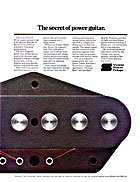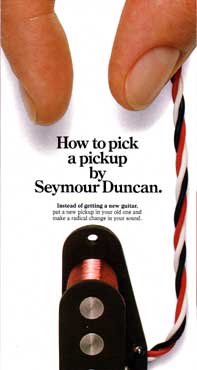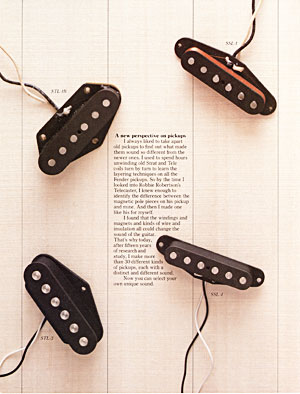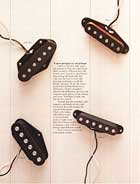|
Guitar Pickups |
 |
 |
 |

I always liked to take apart old pickups to find out what made them sound
so different from the newer ones. I used to spend hours unwinding old Strat
and Tele coils turn by tum to learn the
layering techniques on all the Fender pickups.
So by the time I looked into Robbie Robertson's Telecaster, I knew enough to identify
the difference between the magnetic pole pieces on his pickup and mine.
And then I made one like his for myself.
I found that the windings and magnets and kinds of wire and insulation all could change
the sound of the guitar.
That's why today, after fifteen years of research and study, I make more than 30
different kind of pickups, each with a distinct and different sound.
Now you can select your own unique sound.
Leo Fender's 1948 Broadcaster solid-body guitar revolutionized music. The magnetic pole pieces in
the pickup magnetized the strings, so when the strings vibrated, they moved a magnetic field
through the coil windings at the same frequency. That set up an alternating current that went
to the amplifier to be changed back into sound.
Today those vintage instruments are in great demand. Masters like Roy Buchanan and James Burton
like the rich distinctive sound they get from their ancient Telecasters (for legal reasons,
Fender dropped the name "Broadcaster" in 1950).
The pole pieces in the pickups on those vintage instruments have slowly lost magnetic strength
over the years, and that's part of the reason for the perfect blend of top and bottom frequencies.
If a pickup is supposed to be a "vintage", it should be exactly like the original, down to
the smallest detail. That's why I magnetize all my pole pieces myself, instead of using
pre-magnetized Alnico, and I've developed a two-stage Duncan-Aged process that gives my
pickups the same field strength as the originals.
The Broadcaster had a ferrous elevator plate on the bottom of the pickup to reflect
the magnetic field up to the strings, and so my STL-lB does, too. The STL-lB duplicates
the fatter, most sought-after early Telecaster sound.
In 1954, Fender made some changes in the Telecaster lead pickup. He extended the two
center pole pieces closer to the strings. He used smaller diameter magnets too; the
result was a strong clear response to higher notes, a bright and biting sound.
The STL-l has the same distinctly vintage look as the "Broadcaster", with black waxed string
wrapped around the coil and fibreboard bobbins lacquered for insulation. And
the magnets are Duncan-Aged. The STR-l rhythm pickup is wound and magnetized to
perfectly balance either the STL l or the STL-lB.
I worked for a few years at the Fender Service Center in London and repaired guitars and pickups for musicians like Jeff Beck and David Gilmore. I learned how to wind a really hot Tele, one with high resistance and high output. My STL-2 sends a lot of current into the amp. It delivers a fat full punch on the low frequencies, while still retaining "the edge" many players want. The coil is extra sensitive and, combined with custom-length flat pole pieces, it picks up the faintest string vibrations for great sustain.
I wanted a Tele pickup with enough power to compete with humbuckers, and so did a lot of
other musicians. I tried many methods, but all the extra windings necessary changed the
size and shape of the-pickup. The ideal unit would plug into an ordinary Telecaster without
modification.
I found a way to do it, after a lot of research. I discovered that the stronger and
wider magnetic field created by quarter-inch-thick pole pieces increased the output,
while letting me use a special winding that wouldn't sacrifice the high end or make
the sound muddy.
The STL-3 has great treble bite and a full powerful midrange; it's the sound I always knew
I wanted but couldn't get, and it's one of my most popular pickups today. It's unmistakably
different. I hand- polish the Quarter Pounder pole pieces so people can see the difference.
Fender introduced his 3-pickup Stratocaster in 1954. The modern guitars look the same, but
the pickups-and the sound-haven't been the same since CBS bought Fender out in the early 60's.
Fender cut the pole pieces to different lengths for each string to get the maximum of both
sustain and tone; the unexpected interphasing of the staggered magnetic fields gave
birth to the unique vintage Strat sound.
My SSL-l has the exact appearance and the elusive sound of those early Strat pickups.
I hand grind a bevel on each pole piece. I wind the coil with the same gauge wire Fender
used, with the same film insulation, and I keep the wire tension balanced during each
carefully counted turn. Every detail is important to get the fat full sound, the
smooth unharsh top end, that made the vintage Strat famous.
12-page product catalog, 8.5" x 11"  |
 Telecaster and Stratocaster |
 Humbuckers |
 Custom rewinding |